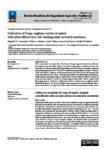Por favor, use este identificador para citar o enlazar este ítem:
http://www.alice.cnptia.embrapa.br/alice/handle/doc/1045113Registro completo de metadatos
| Campo DC | Valor | Lengua/Idioma |
|---|---|---|
| dc.contributor.author | GUIMARÃES, M. J. M. | pt_BR |
| dc.contributor.author | SIMOES, W. L. | pt_BR |
| dc.contributor.author | TABOSA, J. N. | pt_BR |
| dc.contributor.author | SANTOS, J. E. dos | pt_BR |
| dc.contributor.author | WILLADINO, L. | pt_BR |
| dc.date.accessioned | 2016-05-16T11:11:11Z | pt_BR |
| dc.date.available | 2016-05-16T11:11:11Z | pt_BR |
| dc.date.created | 2016-05-16 | pt_BR |
| dc.date.issued | 2016 | pt_BR |
| dc.identifier.citation | Revista Brasileira de Engenharia Agrícola e Ambiental, v. 20, n. 5, p. 461-465, 2016. | pt_BR |
| dc.identifier.issn | 1807-1929 | pt_BR |
| dc.identifier.uri | http://www.alice.cnptia.embrapa.br/alice/handle/doc/1045113 | pt_BR |
| dc.description | This study aimed to evaluate the cultivation of forage sorghum subjected to different leaching fractions with saline effluent from fish-farming under semiarid conditions. The experiment was set in a randomized block design, with four blocks, in split plots, composed of four leaching fractions (0; 5; 10 and 15%) and three forage sorghum varieties (Volumax), ?F305? and ?Sudão?). Irrigation was performed using saline effluent from fish farming with electrical conductivity of 2.5 dS m-1. The analyzed variables were: plant height; stem diameter; width, length and number of leaves; fresh and dry matter yield, and relative contents of potassium and sodium in the shoots. Forage sorghum under saline effluent irrigation and leaching fraction of 15% shows a yield increase of 25%, in comparison to sorghum without the leaching fraction. The variety Volumax was more sensitive to salinity than the others, since it showed lower shoot growth and low values of leaf area, fresh matter and dry matter. | pt_BR |
| dc.language.iso | eng | eng |
| dc.rights | openAccess | eng |
| dc.subject | Fração de lixiviação | pt_BR |
| dc.subject | Sorghum | pt_BR |
| dc.title | Cultivation of forage sorghum varieties irrigated with saline effluent from fish-farming under semiarid conditions. | pt_BR |
| dc.type | Artigo de periódico | pt_BR |
| dc.date.updated | 2017-01-26T11:11:11Z | pt_BR |
| dc.subject.thesagro | Sorgo forrageiro | pt_BR |
| dc.subject.thesagro | Salinidade | pt_BR |
| dc.subject.thesagro | Sorghum Bicolor | pt_BR |
| dc.subject.nalthesaurus | Grain sorghum | eng |
| riaa.ainfo.id | 1045113 | pt_BR |
| riaa.ainfo.lastupdate | 2017-01-26 | pt_BR |
| dc.identifier.doi | 10.1590/1807-1929/agriambi.v20n5p461-465 | pt_BR |
| dc.contributor.institution | MIGUEL J. M. GUIMARÃES, UNIVERSIDADE FEDERAL RURAL DE PERNAMBUCO | pt_BR |
| dc.contributor.institution | WELSON LIMA SIMOES, CPATSA | eng |
| dc.contributor.institution | JOSÉ N. TABOSA, INSTITUTO DE PESQUISAS AGRONÔMICAS | eng |
| dc.contributor.institution | JOSÉ E. DOS SANTOS, INSTITUTO DE PESQUISAS AGRONÔMICAS | eng |
| dc.contributor.institution | LILIA WILLADINO, UNIVERSIDADE FEDERAL RURAL DE PERNAMBUCO. | eng |
| Aparece en las colecciones: | Artigo em periódico indexado (CPATSA)  | |
Ficheros en este ítem:
| Fichero | Descripción | Tamaño | Formato | |
|---|---|---|---|---|
| Welson20162.pdf | 964.58 kB | Adobe PDF |  Visualizar/Abrir |









